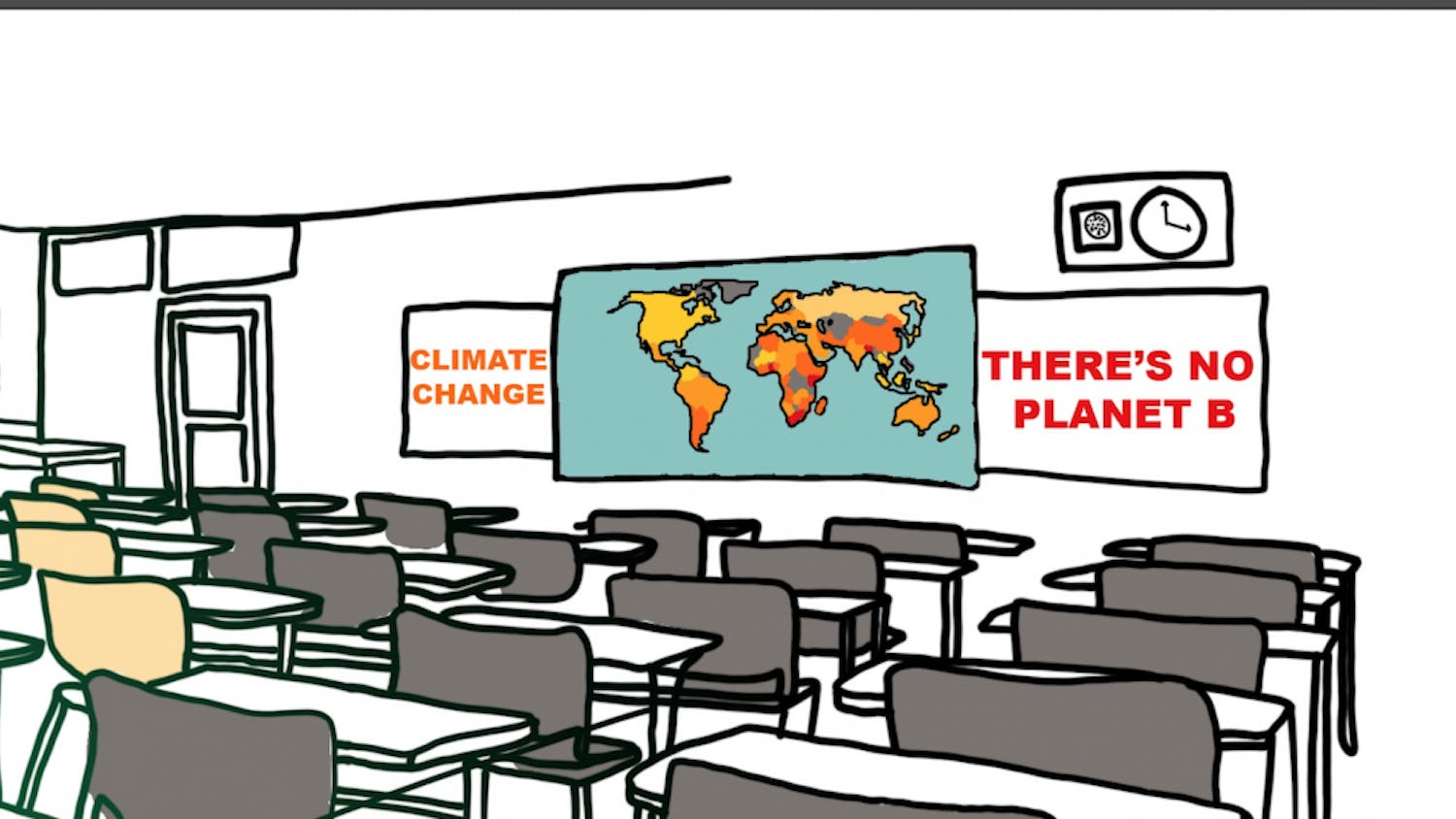A shirt is more than just a shirt. When you buy an item of clothing, you are purchasing more than just colorful stitching or a layer of protection; you’re spending money on the fabric’s past and playing a part in its future.
Environment, business and social factors all intertwine in the world of fashion, said Majid Sarmadi, Rothermel Bascom professor of Design Studies at the School of Human Ecology. The fashion industry is wide-reaching, affecting local communities as well as economies in regions as far away as the Middle East and Africa.
Everyone wears clothes and uses textiles in some way, shape or form. This is part of the reason why the fashion industry is expansive; in fact, it is an industry that is larger than books, movies and music, according to Maria Kurutz, a UW-Madison design studies professor.
However, the textile industry is also the second biggest pollutant industry in the world, said Sarmadi.
The human population has increased 2.68 times since the 1950s, and the consumption of textiles since then has increased by 36.4 folds. Currently, 85.9 million metric tons of textiles are sent to landfills annually, according to Sarmadi.
Fashion is an industry — like many others — beginning to face the realities of environmental consciousness. The fashion industry employs processes that use a lot of water, pollute air and water, may create unnecessary waste, generate greenhouse gas emissions and can ultimately lead to reduced available farmland.
Water usage
“I think we are producing more clothing and wearing more clothing and disposing more clothing — and of course, the population is bigger than it's ever been,” Kurutz said. “People are realizing that our resources are not limitless, and there is going to be a point where clean water is going to be a valuable commodity. And it takes a lot of water to produce textiles — for example, to dye or stonewash or prepare denim.”
Textile treatment and dying make up 20 percent of industrial water pollution, according to sustainyourstyle.org. 2900 gallons of water are required to make one pair of jeans and 766 gallons are needed for one cotton shirt, according to Sarmadi. In context, 25 percent of all water in the world is freshwater, and only 0.3 percent of that water is available to humans.
Fast Fashion
Fast fashion is fashion that is designed to be only worn a few times and then is thrown away, according to a general definition by Jerry O’Brien, executive director at the Kohl’s Center for Retailing. It hits the market faster, is created in a very quick turn out, and is typically produced overseas. Fast fashion is not designed to be high quality.
“I mean, it’s disposable,” he said. “So what it means is, we are creating millions of tons of product that will have a short, useful life, and then become part of a landfill, or donated — which is another angle to the problem.”
“We are beginning to realize we cannot afford to be making stuff to throw it away,” O'Brien said.
Many consumers do not understand the consequences of fast fashion purchases, however.
“If you are shopping [at a fast-fashion clothing store], you are essentially saying — ‘I am okay with getting the cheapest, most exploitative, most environmentally awful product that's out there, because it's cheap,’” said Tom Eggert, a senior lecturer in the Nelson Institute for Environmental Studies who teaches at the intersection of business and sustainability.
“We send the message into the market that it's ok to do stuff like that, and so we get more of it done,” Eggert said.
The role of the consumer and producer
“Do I need something? Or do I want something?” Is the question Sarmadi says consumers should be asking.
Though Sarmadi acknowledges that oftentimes we do need things for our emotional wellbeing, he also urges us to understand that our resources are limited, like money that is only withdrawn from a bank, never deposited.
Both consumers and producers can participate in sustainable fashion practices. Sustainability was originally defined by the United Nations as “meeting the needs of the present without compromising the ability of future generations to meet their own needs.”
For starters, one can focus on purchasing from brands that “upcycle” to make their clothes. Upcycling is the recycling of unwanted products to make new products. Some brands that do this are Patagonia, Timberland, Good Karma, Beyond Retro and Zero Waste Daniel.
Sarmadi also advocates for the use of synthetic over natural fibers, which need farm land to be cultivated, pesticides and herbicides which then pollute surrounding water, a long growing season and a large amount of electricity.
Natural fibers also lose color quickly — meaning that clothing constructed out of natural fibers is more likely to be thrown away sooner than clothing constructed of synthetic fibers.
“What we have to do is reduce, reuse, recycle and reinvent,” Sarmadi said. "We are all in the same boat.”
The world of thrift
Thrift stores play an important role in diverting waste from landfills, said Senior Community Engagement Director at St. Vinnys in Wisconsin Lauren Cnare. In 2016, 1,600 tons of textiles were recycled. 125,000 cubic yards of donations total — including more than just textiles but also items such as shoes, accessories, paper, cardboard, metal and wire — were diverted from the landfill.
A lot of clothing that isn’t recycled is given away. Cnare said that in 2018, approximately $300,000 worth of free clothing was donated to individuals who needed it and could not even afford thrift store prices.
The process for St. Vinny’s begins when they receive a huge amount of donated clothing. They put everything that is saleable on their shelves; What does not sell in stores is then brought over to Dig and Save, where clothes sell by the pound. Clothing still not sold at Dig and Save is then sold to aggregators, who recycle and resell some portion of the clothing.
Clothing that absolutely cannot be recycled or reused is sent to the landfill.
40 to50 percent of thrift store profits go towards supporting services like food pantries, housing programs, a free pharmacy for the uninsured and vouchers for free items.
Other thrift stores, such as Goodwill of South Central Wisconsin, engage in the same practices.
Global Fashion
There is an entire secondary market for those who buy recyclable material. However, this process can be controversial. While Goodwill diverted 4,981,036 pounds of textiles from the landfill in 2018, a percentage of those clothes were sent to a vendor, who then sent the clothing to markets in the Middle East, where the clothing was then resold once more.
The practice of sending clothing to regions such as the Middle East or East Africa is controversial, according to O’Brien.
“The unintended consequences are bad — on the continent of Africa there is very little textile industry at all, there is so much clothes flooding in, primarily from the United States, so how would you compete making your own when it comes in already made and free?” O’Brien asked. ”It really holds back an entire industry that might be helpful.”
Secondary Materials and Recycled Textiles, or S.M.A.R.T., is an international trade organization that works with for-profit textile-recycling member companies to raise awareness and ensure textile reuse and recycling. Their slogan is “donate, recycle, don’t throw away.”
Jackie King, Executive Director of S.M.A.R.T., said that the members of S.M.A.R.T. work in three primary areas of clothing and textile recycling, each with the primary goal of diverting items from landfills.
The first group works with the reuse of clothing, which sells to thrift stores and other countries. The second group cuts up clothing and textiles that are not viable to be used as clothing and turn them into wiping rags. The third group works with cloth items that cannot be turned into clothing or wiping rags and grind the items into fibers, which can be turned into other materials.
King contends that the process of sending items overseas is beneficial.
“[it’s] making sure that these materials are used to their fullest extent,” King said. “Being able to find markets for [reused clothing], not just here in north america but all over the world ... and it's quality affordable clothing that a lot of times [is going to] countries [that] cannot afford new clothing, this is their best alternative that they can use to clothe themselves and their family.”
Meanwhile, Eggert says that there is a financial benefit to this process, as sending items to the landfill costs money and an organization can make money by sending items overseas.
Eggert, who was the first to teach a sustainable business class at UW-Madison, says that contrary to popular belief, business and environmental interests are closely linked.
“For years there has been a vested interest in talking about the economy and the environment as antithetical to each other,” Eggert said. “And for the last fifteen or twenty years we have had very good evidence that this is not the case. ... the companies that are doing the best, on a number of different criteria, are the ones that are the most thoughtful about the both the environmental and their social performance.”
Choosing an item of clothing is not merely about how much it costs or how good it looks, but what impact it will have on the world. Consumers have power to communicate to the market that they want to shop sustainability, said Eggert.
“Businesses are going to do whatever customers are going to ask them to do,” he said. “If your customers are asking you to do something and you don't, you risk going out of business at that point.”
Sarmadi says that in order to save the planet, we must stop consuming and producing as we have been.
“If scientists come up with a system that is not economical, no one is going to buy it,” Sarmadi said. “If we forget about the environment, then we have a problem. If we forget about the social issues that people are worried about, then people are going to revolt.”






